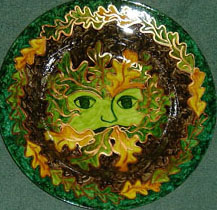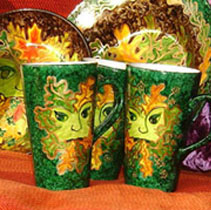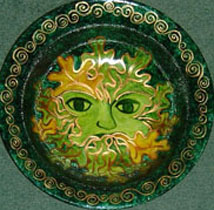 |
|
|
The Mystery of the Green Man By Michelle Jones Who or what is The Green Man? - We have all seen him, peering through his foliage, in churches, cathedrals and in virtually every 'New age' shop in the country. As little as fifteen years ago, there was only one, out of print, book to be found on the subject; now there is a proliferation of books, each offering their own theories and ideas and there are countless 'Green Man' things to buy, from wall plaques and T Shirts to jewellery and fridge magnets! To try and discover his origins, we must first look at the great gothic churches and cathedrals of England and Europe. It is an astounding fact that the images of the Green Man outnumber the images of Christ by approximately twelve to one…so surely there must be some written records in the construction accounts of the buildings? There is not a single word written, all we have are the faces, carved from wood and stone. We do know that in England the concept of the Green Man carving in churches was probably imported from France via the Normans - and before you all cry out 'Surely Not!', go and look at pre-Norman churches for yourself! The image of the Green Man appears in many cultures across the globe, for example in China, Mexico and India - and in some ancient Hebrew Scripts, all these places developing separately from each other with their own customs and traditions. He has been linked with various English customs and traditions, for example The Morris Dance, Robin Hood, the story of Gawain and the Green Knight from the Arthurian tradition, tree spirits and tree worship, The Druids, Herne the Hunter and other 'Wild Men' myths, and the Jack-in-the-Green festivities. There are many pubs up and down the country called 'The Green Man' depicting his head on the sign. Incidentally, until 1939 the images of the Green Man were only known as 'Foliate Heads', it was a noblewoman, Lady Raglan, who gave him his now familiar name, which she took from the numerous pubs! Unfortunately, again, there is very little written or historical evidence for any of these links and it is difficult to pin down exactly when these connections started. Jack-in-the-Green is worth looking at however. This festival, which is still carried on today, in several towns and cities in England, is held around the beginning of May and is closely linked to the fertility of the spring and summer months. The central figure is a man wearing a sort of giant Christmas tree made from wicker and foliage. The first written account for this custom dates back to 1801, but it is clear that the writer is assuming that it goes back much further. If you go to Hastings for the Jack-in-the-Green festival at the beginning of May, you will still find the archaic figure dressed in greenery walking in the procession, along with gigantic human figures to represent other mythical figures. |
|
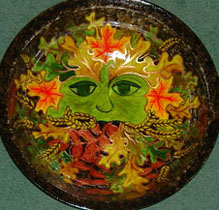 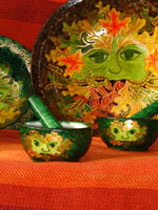 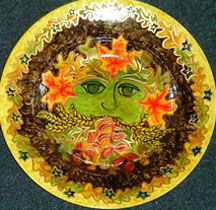
So where do we go from here? If we go further back into history we see a link with the masks worn by the priests and shamans of various cultures, including the Romans, Greeks, Egyptians, Mayans, Native Americans and ancient Persians. I feel however, that in order to understand the Green Man, we must travel even further… In your mind, travel back in time, back to the very dawn of mankind…when life was ruled by the seasons, when we lived hand in hand with the land and not remote from it as most of us do today. Our ancestors were in tune with the rhythm of the Sun and the Moon. During the summers they watched the gradual process of the Sun lowering in the sky. Then the nights really draw in and it becomes much colder, the land becomes still as animals begin the long months of hibernation and the trees lose their leaves. Then comes the Winter Solstice, the darkest time of the year, a time to huddle around the fire and pray the food does not run out before the advent of spring. This was a time for story telling and ritual to ensure the return of the life-bringing Sun. Here we do find links with our customs today - the holographic tinsel that you drape around your Christmas tree is a modern incarnation of the greenery traditionally brought in, in defiance of the cold. We know, from archeological remains, that the ancient shamanic priests wore masks; from here we can easily imagine that one of these masks might have depicted a 'Green Man', to symbolize the return of the spring leaves. |
|
|
As the wheel of the year continues to turn, the days lengthen and the land is warmed by the Sun as it climbs ever higher until we reach May Day. Now we see an abundance of greenery about us as everything is fertile - and our ancestors celebrated the dawn of summer. At Summer Solstice the Sun reaches its zenith, food is plentiful, but now the Sun slowly descends once more, the harvests are gathered in and laid up for the cold months ahead and once more the wheel turns. The Christmas carol 'The Holly and the Ivy' which dates back to the early 18th century, is itself based on an older folk song, which may go back to medieval times and beyond. In Scandinavia, holly has been revered since ancient times. This carol deals with the rivalry between the male holly and the female ivy and may have ancient connections with the symbolism that the Green Man would seem to represent, namely the birth, death and rebirth cycle and the ability of some plants to withstand the winter months without losing their leaves. One of my favourite stories is that of the Oak King and the Holly King. The tale is circular with no beginning or ending and is that twice a year the Holly King and the Oak king have a battle for control of the land. At the Winter Solstice the Oak King wins and the land becomes green and verdant under his reign, at the Summer Solstice the Holly King triumphs and the land gradually falls asleep, with only the evergreens to remind us of warmer times. This story seems to me to sum up the reasons for the existence of the Green Man. For all the images of him, there are no written records - why? I think that once upon a time, we did not need to be told who he was or what he represented. We knew, in the same way that we know the cycle of the seasons. Time passed, and gradually, over the years, we began to forget. We developed as a society and science took away the fear that the sun would not return - and as a result, the need for rituals to ensure fertility died out. Only in a few remote corners of the land, did the old ways persist, and even then people only carried them on because it was 'traditional' with no real sense of the reasons behind them. After many years lying forgotten in the corners of our churches, he has slowly insinuated himself back into our consciousness. He is a symbol of continuity, who takes us from the far distant past into the future at a time when concern for the fate of our planet in increasing. We need to regain that instinctive connection with the land - perhaps the Green Man can show us the way.
All Green Man pieces are handpainted and unique. Please email me for details. Prices range from £10 for an ordinary mug to £60 for a large bowl, painted on both sides |
 |
.jpg) |
 |
 |
 |
 |
 |
 |
 |
 |
 |
 |
 |
 |
 |
